IVY : Hedera helix and Hedera hibernica
As can be seen from the botanical names above, there are two native species in the UK and these are hard to distinguish from each other. (There are other introduced species which may sometimes be found growing wild).
Hedera helix is common ivy which can be found throughout the UK, while Hedera hibernica is Atlantic ivy and is more likely to be found on the west of Britain and Ireland.
Ivy is an evergreen, woody climber which can grow to a height of 30m. You may have seen it high up against the side of buildings or supported by trees. The juvenile and mature forms can look a little different. Older plants may become self supporting. All ivy climbs using specialist hairs with which it sticks to surfaces.
A cultivar of hibernica ie Atlantic ivy and generally simply called hibernica has taken to being simply ground cover and may become invasive. Most ivy though will grow along the ground for some distance in search of vertical support.
Dark green and glossy with pale veins. Juvenile leaves have 3-5 lobes and a pale underside. Mature leaves are oval or heart-shaped without lobes. Common ivy has leaves with 3-5 lobes, while Atlantic ivy has leaves with 5-7 lobes. [Woodland Trust].
A somewhat surprising characteristic is that they bloom in autumn while most other plants are well past that stage. Only mature plants produce flowers. They first start to appear as small round green clusters of stalks balls at each end ie umbrels. These eventually become black, berry-like fruits.
The fruits of common ivy are typically larger and more glossy than the fruits of Atlantic ivy.
If left unchecked, it can become problemmatic on buildings and needs to be severely cut back, but it will readily recover and grow up again. It often appears to be throttling supporting trees. This is not the case as the root remain independent even if the supporting hairs grab onto the host, but smaller trees may succumb to the weight.
Ivy supports a great variety of wildlife. Some of us may find squirrels and even rats climbing into our roofs with the aid of ivy as a ladder.
The Woodland Trust tells us : The ancient Greeks and Romans believed that wearing a wreath of ivy leaves around the head would prevent one from getting drunk. The Roman god Bacchus, the god of intoxication, was often depicted wearing a wreath of ivy and grapevines. You will often see this in art from the period. Ivy was also a symbol of intellectual achievement in ancient Rome and wreaths were used to crown winners of poetry contests. Wreaths were also given to winning athletes in ancient Greece.
Ivy was a symbol of fidelity and so priests would present a wreath of ivy to newly married couples. Today it is still the custom for bridal bouquets to contain a sprig of ivy.
Wiki adds : The clinging nature of ivy makes it a symbol of love and friendship, there was once a tradition of priests giving ivy to newlyweds, and as it clings to dead trees and remains green, it was also viewed as a symbol of the eternal life of the soul after the death of the body in medieval Christian symbolism. And it appears in Christmas carols such as the Holly and the Ivy - the ivy evidently representing the Virgin Mary.
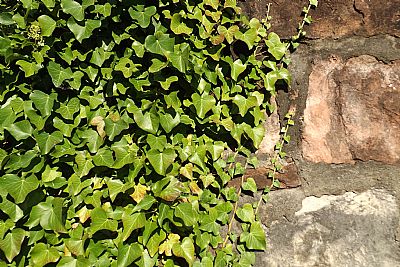
Ivy growing up the stone wall of the distillery on the Leven towpath.
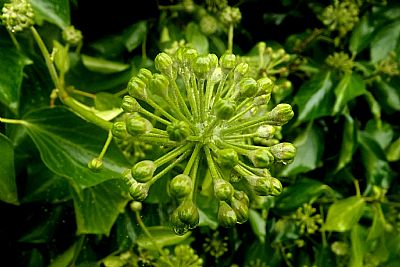
The early stages of an ivy flower in October.
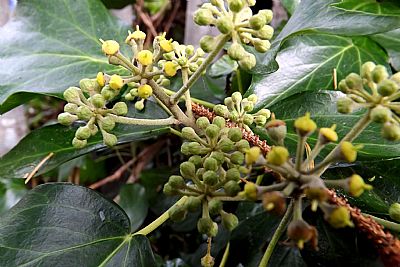
And into November
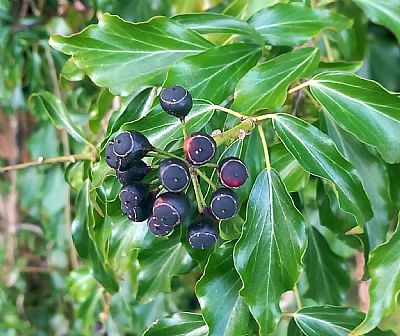
By late winter, into spring, the berries are almost ready for reseeding.
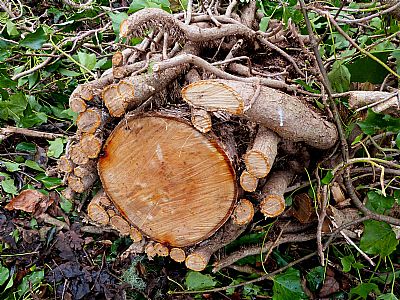
Ivy does not do much damage by clinging to trees through its tentacle-like roots, but the sheer weight of them can bring both them and the supporting tree down. In fact this is quite common. This one was seen once cut after Storm Eowyn in February 2025.
WIKIPEDIA : https://en.wikipedia.org/wiki/Hedera

